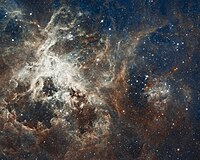Astronomers discover largest star on record
Wednesday, July 21, 2010

Image: NASA/ESA.
European astronomers have discovered the most massive star yet on record; it is approximately 300 times the mass of our sun, beyond the previously accepted limit of 150 solar masses.
Paul Crowther, professor of astrophysics at the University of Sheffield, led the team of researchers that discovered the star. The team used the Very Large Telescope (VLT) in Chile, and data archived from the Hubble Space Telescope. The newly discovered star, designated R136a1, was discovered in the R136 star cluster.
The researchers estimate that the current mass of the star is about 265 solar masses, and could have been about 320 solar masses just after its birth.
"Unlike humans," says Crowther, "these stars are born heavy and lose weight as they age. Being a little over a million years old, the most extreme star R136a1 is already middle-aged, and has undergone an intense weight loss programme, shedding a fifth of its initial mass over that time, or more than 50 solar masses."
Astronomers not involved in the discovery, while still impressed, warn of the small possibility that the team could have mistaken two relatively close stars for one large one.
"What they're characterizing as a single massive star," Mark Krumholz told the Associated Press, "could in fact be a binary system too close to be resolved." Krumholz is an astronomer at the University of California.
Another astronomer, Phillip Massey from the Lowell Observatory in Arizona, also warns that this may be the case. Massey explained that the star's weight had been inferred using scientific models that were subject to change.
The R136 star cluster, the star's location, is in the Tarantula Nebula in the Large Magellanic Cloud, a neighboring galaxy about 165,000 light-years away. The Large Magellanic Cloud, located between the constellations Dorado and Mensa, is visible as a faint cloud in the southern hemisphere. Astronomers are still struggling to understand how these stars form.
"Either they were born so big or smaller stars merged together to produce them," Crowther explained. The researchers believe that the stellar heavyweight record could be held by this star for quite some time. Crowther elaborates: "Owing to the rarity of these monsters, I think it is unlikely that this new record will be broken any time soon."
Sources
- Raphael Satter. "Scientists find most massive star ever discovered" — Associated Press, July 21, 2010
- "Largest ever star discovered" — TG, July 21, 2010
- "Heftiest star discovery shatters cosmic record" — Space.com, July 21, 2010
External links
- "Science Release: Stars Just Got Bigger, A 300 Solar Mass Star Uncovered" — European Southern Observatory, July 21, 2010: more details, images and a video.
- Crowther, Paul A. et al (2010). "The R136 star cluster hosts several stars whose individual masses greatly exceed the accepted 150 M⊙ stellar mass limit". Monthly Notices of the Royal Astronomical Society 406. ISSN 0035-8711. In press. 20 page preprint online courtesy of ESO
